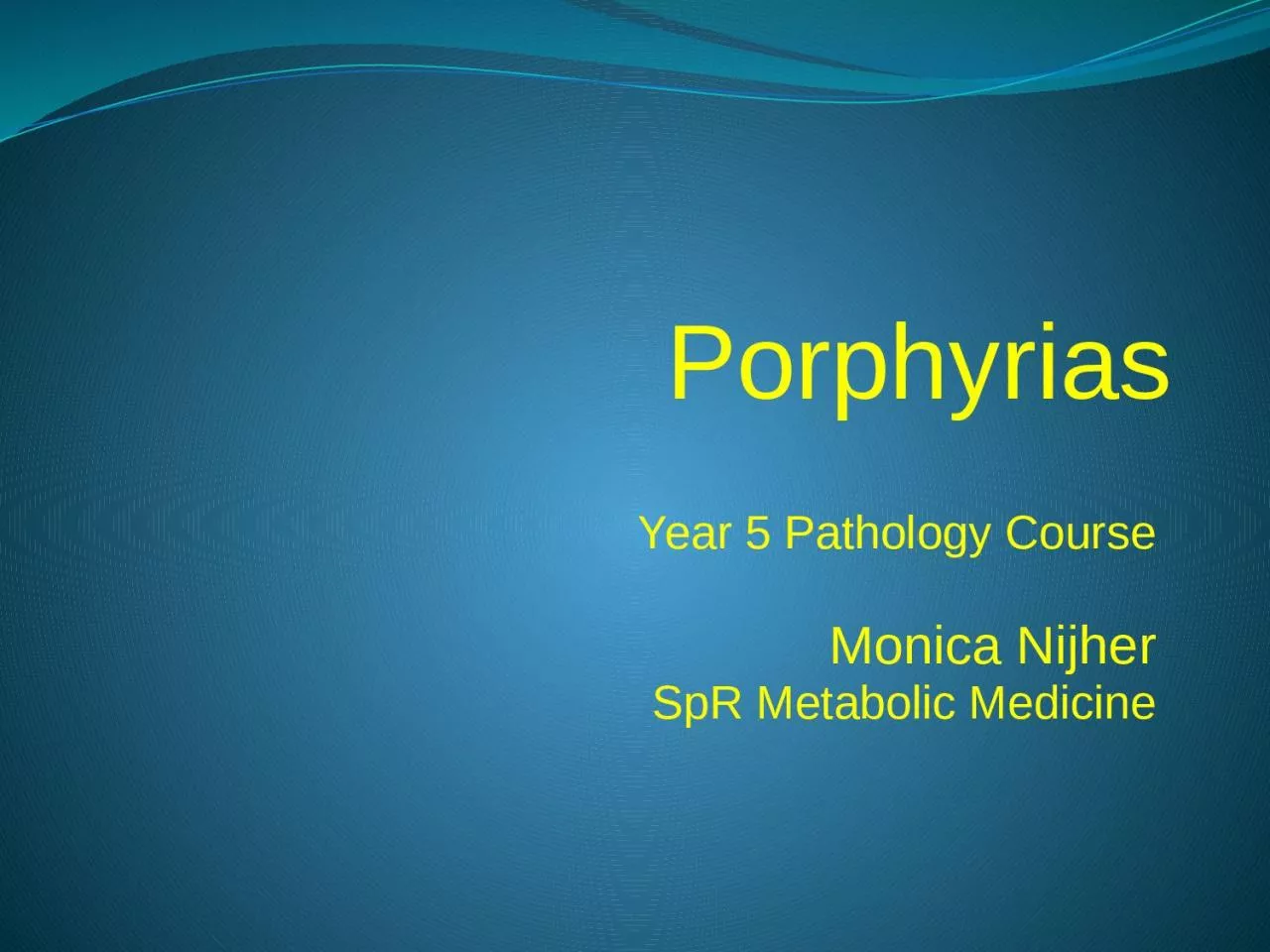

Monica Nijher SpR Metabolic Medicine Enzyme deficiency the principles A B C Enzyme 1 Enzyme 2 x B C Definition Group of eight disorders caused by deficiencies in the activities of the enzymes of the ID: 1048377
Download Presentation The PPT/PDF document "Porphyrias Year 5 Pathology Course" is the property of its rightful owner. Permission is granted to download and print the materials on this web site for personal, non-commercial use only, and to display it on your personal computer provided you do not modify the materials and that you retain all copyright notices contained in the materials. By downloading content from our website, you accept the terms of this agreement.
1. PorphyriasYear 5 Pathology CourseMonica NijherSpR Metabolic Medicine
2. Enzyme deficiency: the principles ABCEnzyme 1Enzyme 2xBC
3. Definition Group of eight disorders caused by deficiencies in the activities of the enzymes of the haem biosynthetic pathway leading to overproduction of toxic haem precursors, and acute neuro-visceral attacks and/or acute or chronic cutaneous symptoms. Partial nearly complete
4. Porphyrias are disorders ofHaem breakdownBilirubin excretionPorphyrin deficiencyBilirubin conjugationHaem biosynthesis
5. HaemSynthesized in all cells 85% erythroid cells (Hb)Most of remainder liver cells (cytochromes)
6. SUCCINYL COA & GLYCINE ALA synthase5-AMINOLEVULINIC ACID ALA hydratase/PBG synthasePORPHOBILINOGENHydroxymethylbilane synthase HYDROXYMETHYLBILANEUroporphophyrinogen III synthase spontaneousUROPORPHYRINOGEN III UROPORPHYRINOGEN IUroporphyrinogen decarboxylase COPROPORPHYRINOGEN III COPROPORPHYRINOGEN ICoproporphyrinogen oxidase PROTOPORPHYRINOGENProtoporphyrinogen oxidase PROTOPORPHRIN IXFerrochetalase & Fe++ HAEM-BILIRUBINBRANCED CHAIN AMINO ACIDSKREBS CYCLE
7. The rate limiting enzyme in the synthesis of porphyrins isALA hydrataseHydroxymethylbilane synthaseCoproporphyrinogen oxidaseALA synthaseProtoporphyrinogen oxidase
8. Classification of porphyriasPrinciple site of enzyme deficiencyErythroid or hepaticClinical presentationAcute or NonacuteNeurovisceral or photosensitising
9. Mechanisms of symptoms/signsNeurovisceral5-aminolevulinic acid is neurotoxicPhotosensitivityPorphyrinogens oxidisedPorphyrins lightActivated porphyrins & O2
10. The Porphyrias
11. The most common porphyria worldwide isAcute intermittent porphyriaPorphyria cutanea tardaPorphyria variegataErythropoietic protoporphyria
12. Acute Intermittent Porphyria (AIP)In generalEnzyme activity 50% normal90% individuals clinically normalSeverest of acute hepatic porphyriasHydroxymethylbilane synthase deficiencyLapland, Scandinavia and UKAutosomal dominantWomen > men
13. SUCCINYL COA & GLYCINE ALA synthase5-AMINOLEVULINIC ACIDALA hydratase/PBG synthasePORPHOBILINOGEN Hydroxymethylbilane synthaseHYDROXYMETHYLBILANEUroporphophyrinogen III synthase spontaneousUROPORPHYRINOGEN III UROPORPHYRINOGEN IUroporphyrinogen decarboxylase COPROPORPHYRINOGEN III COPROPORPHYRINOGEN ICoproporphyrinogen oxidase PROTOPORPHYRINOGENProtoporphyrinogen oxidase PROTOPORPHRIN IXFerrochetalase & Fe++HAEM-BILIRUBINBRANCED CHAIN AMINO ACIDSKREBS CYCLE
14. Acute Intermittent Porphyria (AIP)Clinical findingsAbdominal painNausea, vomitingUrinary retention, incontinence, dysuriaTachycardiaHypertensionFever, sweating, restlessness, tremorPeripheral neuropathyMuscle weaknessSeizuresPsychiatric disturbanceArrhythmias ---- cardiac arrestNO CUTANEOUS MANIFESTATIONS
15. Acute Intermittent Porphyria (AIP)Precipitating factorsALA synthase inducersBarbiturates, steroids, ethanol, anticonvulsantsStressInfection, surgeryReduced caloric intakeEndocrine factorsMore common in women and premenstrual
16. Acute Intermittent Porphyria (AIP)Biochemical findingsIncreased urinary ALA & PBGPBG porphobilin (port wine colour)Decreased HMBS in erythrocytesMolecular biology400 mutations of HMBS gene
17. Acute Intermittent Porphyria (AIP)TreatmentAvoid attacksAdequate nutritional intakePrecipitant drugsPrompt treatment infection/illnessiv carbohydrateiv haem arginate
18. Porphyrins are toxic!
19. Porphyria cutanea tardaHeterogenous groupInherited or acquired Uroporphyrinogen decarboxylase deficiencyFormation of vesicles on sun-exposed areas of skin crusting, superficial scarring, pigmentationBiochemistryUrinary (& plasma) uroporphyrins & coproporphyrins increasedFerritin often increasedAvoid precipitants (alcohol, hepatic compromise)Phlebotomy for those with haemochromatosis
20. SUCCINYL COA & GLYCINE ALA synthase5-AMINOLEVULINIC ACID ALA hydratase/PBG synthasePORPHOBILINOGENHydroxymethylbilane synthase HYDROXYMETHYLBILANEUroporphophyrinogen III synthase spontaneousUROPORPHYRINOGEN III UROPORPHYRINOGEN IUroporphyrinogen decarboxylase COPROPORPHYRINOGEN III COPROPORPHYRINOGEN ICoproporphyrinogen oxidase PROTOPORPHYRINOGENProtoporphyrinogen oxidase PROTOPORPHRIN IXFerrochetalase & Fe++ HAEM-BILIRUBINBRANCED CHAIN AMINO ACIDSKREBS CYCLE
21.
22. “Gollum’s dislike of sunlight may be due to the photosensitivity of porphyria”From the BMJ, Xmas 2004
23. If you suspect an acute porphyria the most useful sample to send to the lab isBloodCSFUrineMuscle biopsyStoolSkin biopsy
24. Approach to diagnosisAcute neurovisceral features OR active skin lesionsQuantify urine ALA & PBG Plasma or urine porphyrin profile Collect and store faecesNormal increased Normal increasedExcludes acute attack. Measure rbc HMBS measure faecal interpret porphyrin profileConsider DNA mutation analysis to identify asymptomatic relatives
25. Clinical Case22 year old femaleOn holiday, drinking heavilyAbdominal pain, nausea and vomitingParanoiaReturned to UKTonic/clonic seizuresBlurred vision, flashing lightsAdmitted to DGH
26. Clinical CaseClinical deterioration Transferred ITU Developed opthalmoplegia, quadraparesis, Respiratory failure - Intubated/ventilated
27. Clinical CaseSerum Na 118 mmol/L (135-145)Plasma osmolality 268 (280-295)Urine Na 70 mmol/LUrine osmolality 308 mmol/kg Urine ALA 207 umol/mmol creatinine (<3.8)Urine PBG 215 umol/mmol creatinine (<1.5)Hydroxymethylbilane synthase 11 nmol/mL red cells (20-42)
28. Diagnoses Acute intermittent porphyria Seizures Quadraparesis SIADHPulmonary emboliTreatment High carbohydrate diet Haem arginate
29. Clinical Progress7 week stay in ITU9 month stay as inpatientJuly 2008: Degree in Tourism, working dailyResidual sensory/motor neuropathyFoot drop, walks with splintsFrequent painful muscle spasms
30. SummaryRare disorders of haem biosynthesisGenetic and acquiredNeurovisceral and/or cutaneous manifestationsMostly asymptomaticCheck before prescribing any new drugs as may precipitate an attackContact lab first if thinking of investigatingNow type in your CID Then press the green enter key
31. ReferencesMetabolism at a Glance; JG Salway, Blackwell PublishingKauppinen R, Porphyrias, Lancet 365:241-52, 2005Anderson KE, Recommendations for the diagnosis and treatment of the acute porphyrias, Ann Intern Med 142:439-450, 2005http://www.uct.ac.za/depts/porphyriahttp://www.porphyria-europe.com
32. WARNING: Your handset will go to SLEEP when not in use. Press * ANY KEY to WAKE UP your handset. Turn your handset (OFF) THEN ON- slide the Power Switch up (I = ON)Wait 4 seconds till GTCO CalComp disappears. It will start scanning.Join the class by pressing the letter <4> and then the green arrow4. It should say “ANS” YEAR5 PATH<C>